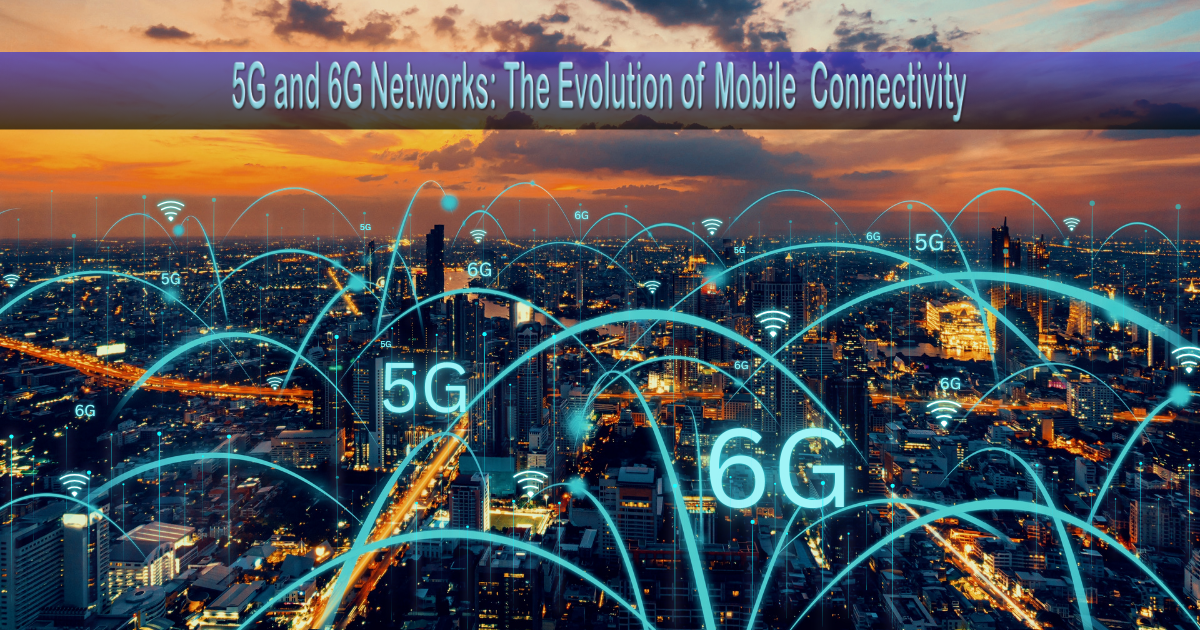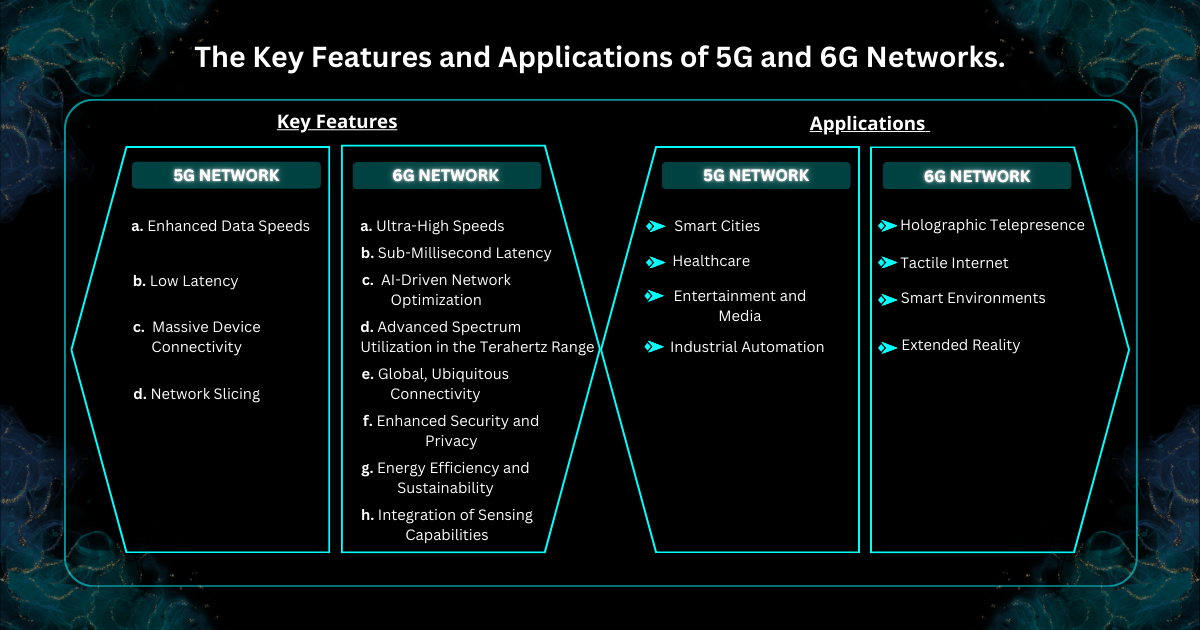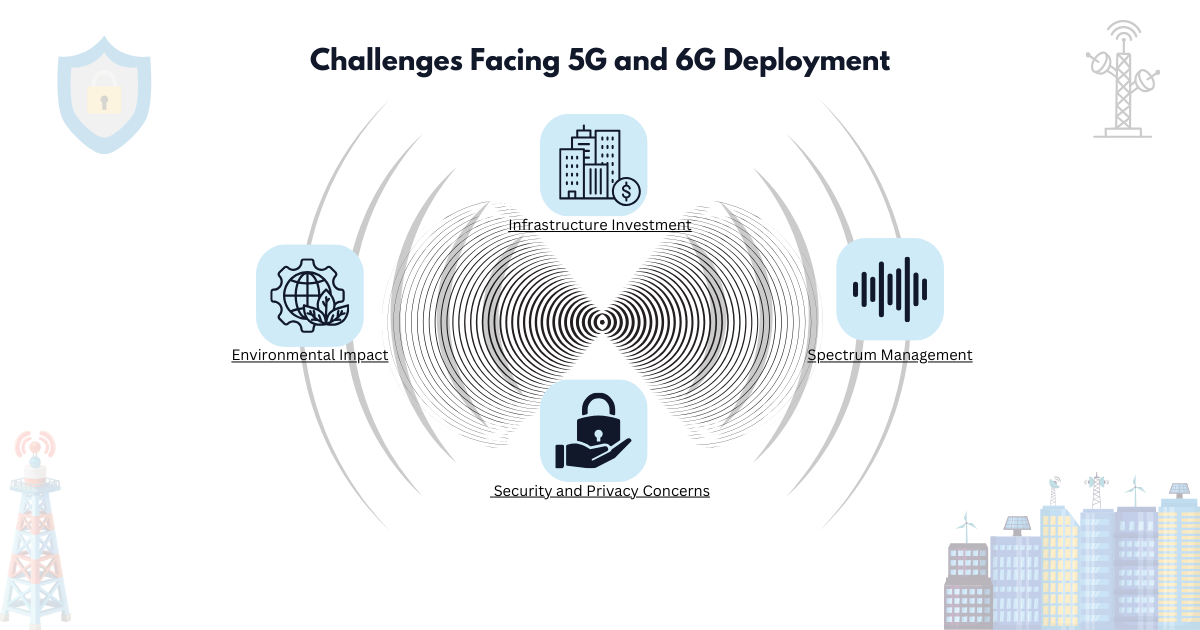
In the rapidly evolving landscape of mobile communication, the transition from 4G to 5G networks represents one of the most significant advancements in technology. As we stand on the brink of another leap into the future with 6G, it’s crucial to understand the implications, capabilities, and potential of these next-generation networks. This article delves deep into the architecture, features, benefits, and challenges of both 5G and 6G networks, providing insights into how they are shaping our world.
I. The Rise of 5G Networks
5G, or fifth-generation wireless technology, was introduced to meet the growing demands for faster internet speeds, lower latency, and greater connectivity. While 4G allowed for streaming high-definition videos and connecting multiple devices, 5G takes these capabilities to a new level.
1. Key Features of 5G
a. Enhanced Data Speeds: 5G networks can offer download speeds of up to 10 Gbps, significantly faster than 4G’s maximum of around 1 Gbps. This increase facilitates seamless streaming of high-resolution content, gaming, and augmented reality (AR) applications.
b. Low Latency: Latency refers to the delay before data transfer begins following an instruction. 5G reduces latency to as low as 1 millisecond, which is crucial for applications like remote surgery, real-time gaming, and autonomous vehicles.
c. Massive Device Connectivity: 5G networks can support up to one million devices per square kilometer, making it ideal for the Internet of Things (IoT), where numerous devices need to connect and communicate simultaneously.
d. Network Slicing: This feature allows multiple virtual networks to be created on a single physical network infrastructure. It provides the ability to tailor connectivity and bandwidth according to the specific needs of different applications, industries, or users.
2. Applications of 5G Technology
The rollout of 5G networks has enabled various applications across different sectors:
- Smart Cities: With the capability to connect a vast number of devices, 5G facilitates smart city applications such as traffic management systems, smart streetlights, and environmental monitoring.
- Healthcare: Remote patient monitoring, telemedicine, and robotic surgery can thrive on the high speeds and low latency provided by 5G networks, improving patient outcomes and access to care.
- Entertainment and Media: 5G enables immersive experiences like augmented and virtual reality, providing users with rich, interactive content.
- Industrial Automation: The manufacturing sector benefits from 5G through enhanced automation, real-time data analytics, and predictive maintenance, leading to increased efficiency and reduced operational costs.
II. The Road to 6G
As 5G continues to be deployed worldwide, researchers and technologists are already looking ahead to 6G networks, expected to be commercially available around 2030. This next generation of mobile technology promises to build upon the foundations laid by 5G, addressing its limitations while pushing the boundaries of what is possible in wireless communication.
1. Anticipated Features of 6G
The development of 6G technology is on the horizon, promising to push the boundaries of wireless communication even further. Expected to arrive around 2030, 6G will bring transformative features that expand upon 5G’s capabilities, enabling unprecedented speed, connectivity, and versatility in mobile networks. Here are the anticipated features that could define 6G and reshape our digital landscape.
a. Ultra-High Speeds
One of the most talked-about features of 6G is its projected speed, which could reach up to 100 Gbps or more—over ten times the maximum speed of 5G. Such ultra-high speeds would enable a seamless exchange of massive data volumes in real-time, empowering applications that require instantaneous data transfer. This improvement will particularly benefit technologies that demand extreme bandwidth, such as immersive virtual reality (VR) experiences, 3D holography, and real-time, data-rich telemedicine.
The increase in speed also means users will experience rapid downloads, near-instant streaming, and other digital interactions without buffering or lag, creating a smoother, more responsive user experience.
b. Sub-Millisecond Latency
While 5G brought latency down to as low as 1 millisecond, 6G is expected to reduce this to sub-millisecond levels, enabling truly instantaneous communication. This minimal latency will be critical for applications like autonomous vehicles, industrial automation, and augmented reality, where even the slightest delay can impact safety or performance.
The sub-millisecond latency feature will also facilitate the development of the “tactile internet,” where users can send and receive haptic feedback over the network. This could allow for applications where touch and physical sensations are transmitted in real-time, enhancing remote surgical procedures and enabling virtual, hands-on experiences in education, gaming, and training.
c. AI-Driven Network Optimization
Artificial intelligence (AI) will play an integral role in 6G networks, transforming how networks are managed and optimized. Through AI-driven algorithms, 6G will dynamically allocate resources, manage data flow, and optimize bandwidth in real-time, responding to network demands as they arise. This smart network management will improve efficiency, reduce energy consumption, and enhance service quality.
In addition to AI-powered optimization, 6G networks are expected to have built-in intelligence that can identify network congestion, predict potential connectivity issues, and adjust the network accordingly to ensure uninterrupted service. AI’s integration into 6G could also facilitate new user experiences by customizing network parameters based on specific needs, such as optimizing for ultra-low latency in remote surgery or maximizing bandwidth for high-resolution streaming.
d. Advanced Spectrum Utilization in the Terahertz Range
6G is likely to operate in the terahertz (THz) frequency spectrum, which will significantly boost its data-carrying capacity. Terahertz frequencies lie above the millimeter wave frequencies used by 5G and allow for the transmission of much larger volumes of data at high speeds. This shift to THz frequencies will enable 6G to deliver ultra-fast connectivity while also supporting a massive increase in device density.
However, THz waves have limited range and are more susceptible to obstacles, such as buildings and foliage. To address this, 6G networks may incorporate a mix of technologies, including intelligent reflecting surfaces, which can redirect signals around obstacles to maintain a stable connection. Additionally, this advanced spectrum utilization will enable high-precision localization and positioning, further benefiting applications like autonomous vehicles, drone navigation, and urban planning.
e. Global, Ubiquitous Connectivity
6G aims to provide ubiquitous, global coverage that will ensure connectivity in even the most remote areas. With the help of satellite technology and high-altitude platform stations (HAPS), 6G could reach underserved regions and bridge the digital divide more effectively than previous generations. This would facilitate equitable access to high-speed internet worldwide, opening up opportunities for education, healthcare, and economic growth in remote communities.
The satellite-backed infrastructure of 6G could also improve resilience in disaster-prone areas, enabling communication networks that stay operational during emergencies, when reliable connectivity is crucial for coordinating response and recovery efforts.
f. Enhanced Security and Privacy
As the number of connected devices grows, so do the security challenges associated with wireless networks. 6G networks are anticipated to incorporate enhanced security protocols, with AI playing a key role in threat detection and prevention. AI-driven cybersecurity will allow 6G networks to monitor for unusual patterns, identify potential threats, and respond to cyber-attacks in real-time.
In addition to cybersecurity, 6G will also prioritize privacy by integrating data protection measures within the network’s core. Advanced encryption techniques and decentralized data management systems are expected to enhance user privacy, addressing the growing concerns around data security in an increasingly interconnected world.
g. Energy Efficiency and Sustainability
6G is designed to be more energy-efficient than its predecessors, aiming to reduce the environmental impact of network operations. By leveraging AI and machine learning, 6G networks will optimize resource allocation, reducing power consumption based on network demand. Additionally, the use of advanced materials and energy-efficient components in infrastructure, such as base stations and antennas, could significantly lower the energy footprint of 6G networks.
To further support sustainability, 6G may incorporate self-sustaining systems, such as energy-harvesting sensors that collect power from environmental sources (like solar or thermal energy). This focus on energy efficiency will not only reduce costs but also align with global initiatives to reduce carbon emissions and foster greener technology solutions.
h. Integration of Sensing Capabilities
6G networks are expected to include advanced sensing capabilities, transforming the network into more than just a communication medium. These networks will be able to gather environmental data and provide contextual awareness, enabling applications in smart cities, health monitoring, and industrial automation. For instance, 6G could allow vehicles to detect objects beyond the line of sight, improving road safety and aiding in autonomous navigation.
Additionally, 6G networks might facilitate precision mapping and positioning, supporting location-based services with unprecedented accuracy. This integration of sensing technology could enable innovations in agriculture, where precise environmental monitoring is key, or in logistics, where real-time tracking can enhance supply chain efficiency.
2. Anticipated Applications of 6G
The advanced capabilities of 6G will enable applications that stretch the imagination:
- Holographic Telepresence: 6G networks could support holographic communications, enabling people to interact in three-dimensional virtual environments. This technology could revolutionize virtual meetings, educational settings, and even social interactions, allowing users to interact with lifelike holograms.
- Tactile Internet: The concept of tactile internet involves transmitting tactile sensations over the network, creating a truly immersive experience. This application could be revolutionary in areas like remote surgery, allowing doctors to “feel” their virtual patients during procedures or training simulations.
- Smart Environments: 6G’s speed and connectivity could facilitate intelligent environments that adapt to human behavior. For example, buildings could adjust lighting, temperature, and even music based on the occupants’ preferences, creating an interactive and responsive atmosphere.
- Extended Reality: Beyond AR and VR, 6G could enable mixed reality environments that blend the physical and digital worlds in real-time, with unprecedented resolution and accuracy. This capability could transform gaming, shopping, and even education.
III. Challenges Facing 5G and 6G Deployment
While the promise of 5G and 6G networks is immense, several challenges must be addressed to realize their full potential.
1. Infrastructure Investment
The deployment of both 5G and 6G requires substantial investment in infrastructure. This includes upgrading existing cell towers, installing new equipment, and ensuring that backhaul networks can handle the increased data traffic. For many regions, especially rural areas, this investment poses a significant challenge.
2. Spectrum Management
The radio frequency spectrum is a finite resource, and as the demand for mobile connectivity grows, efficient spectrum management becomes crucial. Governments and regulatory bodies must develop policies that facilitate spectrum allocation for 5G and future 6G networks while minimizing interference and optimizing usage.
3. Security and Privacy Concerns
As connectivity increases, so do concerns over data security and privacy. With the rise of IoT devices and the potential for increased cyberattacks, ensuring robust security measures will be vital to protect user data and maintain trust in mobile networks.
4. Environmental Impact
The deployment of 5G and 6G networks also raises environmental concerns. The energy consumption of network infrastructure, the lifecycle of hardware, and the electronic waste generated are all factors that need to be considered in the planning and implementation phases.
IV. The Future Impact of 5G and 6G
The widespread adoption of 5G and the eventual deployment of 6G will likely reshape our society in significant ways.
- Enhanced Communication
5G and 6G networks will redefine how people communicate and share information. High-speed networks make it easier for people to connect across vast distances, creating new opportunities for remote work, education, and social interaction.
- Economic Growth
The expansion of 5G and 6G networks is expected to drive economic growth by fostering innovation in multiple sectors, including healthcare, manufacturing, and entertainment. With greater connectivity, businesses can adopt new technologies to increase productivity and reach broader markets.
- Improved Quality of Life
Through applications such as smart cities, remote healthcare, and automated transportation, 5G and 6G have the potential to improve the quality of life for individuals. Smart cities, for instance, can use connectivity to reduce pollution, improve traffic flow, and enhance public safety.
- Bridging the Digital Divide
6G networks, with their global coverage and satellite-based infrastructure, may help bridge the digital divide by bringing high-speed internet access to rural and remote areas. This increased connectivity could provide underserved communities with access to essential services, including education and healthcare.
V. Conclusion
5G networks mark a transformative leap in mobile connectivity, enabling faster speeds, lower latency, and massive device connectivity. As we move towards 6G, the possibilities for innovation and application expand exponentially, promising even greater advancements in communication technology. However, realizing the full potential of these networks will require addressing infrastructure, regulatory, security, and environmental challenges. The journey from 5G to 6G is not just about technological advancement; it is about reimagining how we connect, communicate, and interact with the world around us.



